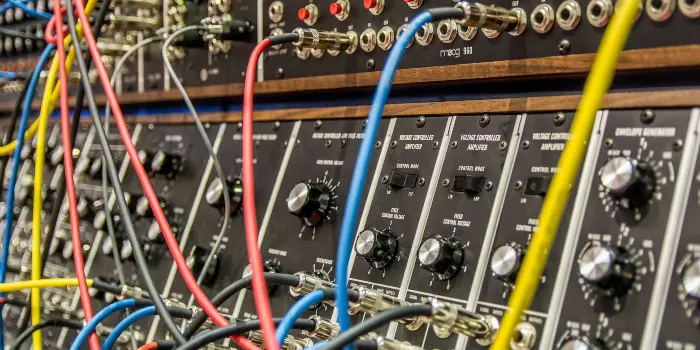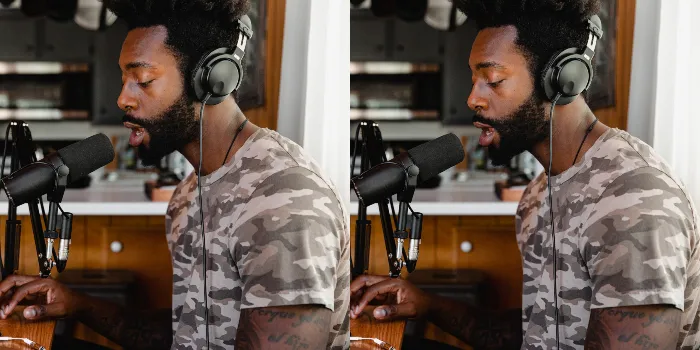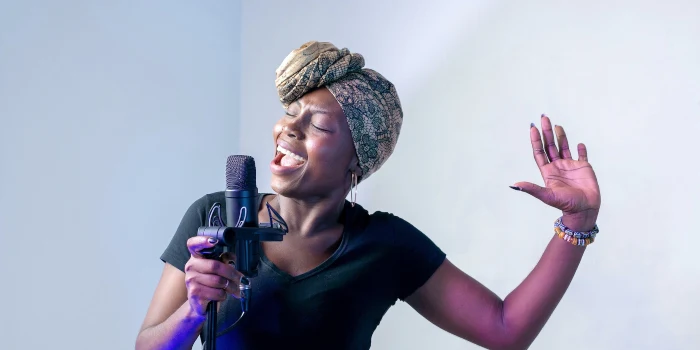You might think that recording a good vocal performance at a home studio is hard. Yes, it’s challenging but not as difficult as you think.
To record vocals in a home environment is easier if you know what to do and how to do it. Even if you don’t have the best gear you can easily record professional-sounding vocal tracks if you have the right guide.
In this simple guide, I will explain what you must do to capture great vocal performances in your home studio.
How To Record Vocals
Recording vocal tracks don’t need to be complicated and don’t require expensive gear. You just need to be prepared and follow certain steps, and you can do it with affordable gear.
1. Prepare The Gear

The first step to recording vocals or any musical instrument is to prepare every recording and do all the connections. You need everything prepared to spend energy and creativity on the recording process.
It means that you need to have every required gear connected and ready for recording. If you have a separate vocal booth for recording, it’s much better. If not, then make sure there is no noise going in the mic.
Connect your recording microphone to your recording device, open the DAW, add a vocal track, and test if you hear the sound. Then do a little tweaking to volume levels until you are satisfied.
Make sure you connected everything needed to record vocals. Test everything and if it works, it’s time to go to the next step.
2. Warm Up Your Vocal Cords

And the next step to recording professional vocal takes in your home is to warm up your vocal cords. Even if the singer is the best in the world he or she needs to warm up before recording.
It’s like when guitar players warm up before recording or live shows. This will help to record better vocal takes without unwanted issues.
Warming up should be quick and not complicated. The singer should sing some melodies, sing high and low notes, etc.
But make sure the singer doesn’t overdo it. Just do what is necessary to prepare cords for recording and warm them up.
3. Record Demo Vocal Takes
Now, when the singer is ready to record it’s time to record some demo vocal takes to see how well singing is captured and if it translates well. Never start recording immediately if you haven’t recorded demo takes.
Demo vocal recordings will help you a lot. You might decide to change the mic or add some compression to the vocal track or use a specific vocal plugin.
Also, there are many cases where the demo recording is so good that it ends up in the final version of the song. The singer could sing the best version in the demo recording and you don’t want to miss it. And never delete any takes you record. You might need it later.
Record every part of the song a couple of times and make sure everything sounds as you want it to sound. If you don’t like something, make changes in this stage.
After you are sure that it sounds good, it’s time to start recording real vocal takes.
4. Record Lead Vocal Take
You should start recording vocals with the lead vocal track and add other vocal layers later. Don’t think anything else than lead vocals because you need this track to be awesome.
If you want to capture the best performance and most natural vocal performance then the singer should sing from start to finish. This will make vocal tracks more cohesive and natural.
Because if you record vocals part by part they will be disconnected and you might not get a good vocal track. Even if the singer makes mistakes, tell him not to stop because you can always rerecord parts that are not as good.
One of the most important things when recording lead vocals is to record it a few times and then choose the best take. A vocalist could be the best singer but not every take will be equal in quality. So, recording several tracks is essential.
After recording several tracks you should listen to all of them a couple of times and choose the best take. Then find mistakes or bad parts and rerecord only that parts.
This way you will have a cohesive and good vocal track without mistakes.
5. Add Vocal Doubles

After the successful lead vocal takes its time to record lead vocal doubles. A vocal double is when you record the same part once again. So, in the end, you will have exactly the same part recorded twice.
The reason for vocal double is to make the vocal more powerful and double vocals help it to cut in the mix. This technique is very famous in every genre of music and even The Beatles used it.
Then in the mixing process, you can use the double vocal track as you want. It is not necessary to have it on all the time. Most times double vocals are used in choruses because it makes the vocal sound bigger and more powerful.
Make sure that both vocal tracks are very tight and they must sound like one track. There mustn’t be phasing or other issues because it will make the vocals sound bad.
Read more about double vocal tracks here.
6. Record Backing Vocals

Every song requires backing vocals because it adds depth and makes songs diverse and interesting. Backing vocals can be sung by one or more persons. It depends on the song.
When it comes to recording backing vocals they should be recorded after the lead and vocal doubles. You need to have the main vocal track add backing vocals because it will make better decisions that way.
The process is the same but you need to think ahead and record correctly. In thinking ahead I mean mixing vocals. You need to think about how backing vocal tracks will sit in the mix, how you will pan them, and so on.
Typically, lead vocals stay in the center but backing vocals can be panned left and right, or you might have different backing vocal tracks on both sides. That’s why thinking about panning during recording is important.
So, you should have a clear idea of how your backing vocals should be in the mix and record correctly from the start.
7. Listen Again And Make Final Edits
Now you have a good understanding of how to record vocals and it’s time for the last step which is making final edits and tweaks here and there. However, these edits should be cosmetic and not drastic changes.
Just listen to the whole mix a couple of times and also listen to all vocal tracks separately to find mistakes or parts that need enhancing. Then rerecord any parts if necessary or make changes from the DAW such as timing, slicing, etc.
The main goal is to have a natural and cohesive vocal recording. Just correct small mistakes such as bad notes, and timing issues, and rerecord parts if only there’s no other way to fix them.
Also, your recorded vocal tracks might be great and sound awesome but they might not sit well in the mix. This will have an impact on the final mix and this should be fixed in this step.
There are cases where you record everything, they sound great separately but not in the mix. Then you might record the whole thing again with a different mic, plugins, etc.
But if you do everything correctly and test everything from the start, you won’t have these kinds of issues.
Conclusion
Recording vocals is as important as recording any instrument so you need to record them correctly from the start. Choose the gear you like, prepare everything, record demo takes, and test how it sounds. After you are satisfied you can start recording lead vocals and follow with vocal doubles and backing vocals.
This simple guide will help you to record vocals in the right way at your home. You don’t need expensive gear but you will need a clear vision of what sound you want to get. Also, test everything before you start the main recording process.

I do agree with all the ideas you’ve offered in your post. They’re very convincing and can definitely work.
Still, the posts are too quick for newbies. May you please lengthen them a little from subsequent time? Thanks for the post.
Thanks for the suggestion. It’s more general guide then step by step but I will definitely make it better in the future.